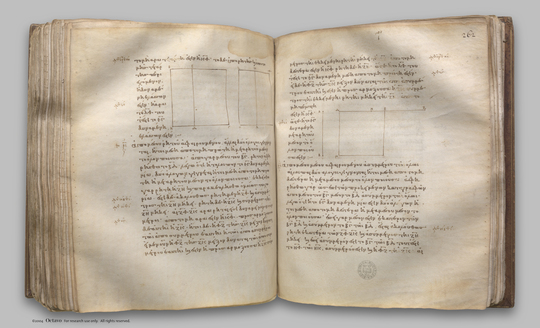index prev next | digilib folio 266

If from a medial area there be subtracted a medial area incommensurable with the whole, the two remaining irrational straight lines arise, either a second apotome of a medial straight line or a straight line which produces with a medial area a medial whole.
| Ἀπὸ μέσου μέσου ἀφαιρουμένου ἀσυμμέτρου τῷ ὅλῳ αἱ λοιπαὶ δύο ἄλογοι γίνονται ἤτοι μέσης ἀποτομὴ δευτέρα ἢ μετὰ μέσου μέσον τὸ ὅλον ποιοῦσα. Ἀφῃρήσθω γὰρ ὡς ἐπὶ τῶν προκειμένων καταγραφῶν ἀπὸ μέσου τοῦ ΒΓ μέσον τὸ ΒΔ ἀσύμμετρον τῷ ὅλῳ: λέγω, ὅτι ἡ τὸ ΕΓ δυναμένη μία ἐστὶ δύο ἀλόγων ἤτοι μέσης ἀποτομὴ δευτέρα ἢ μετὰ μέσου μέσον τὸ ὅλον ποιοῦσα. Ἐπεὶ γὰρ μέσον ἐστὶν ἑκάτερον τῶν ΒΓ, ΒΔ, καὶ ἀσύμμετρον τὸ ΒΓ τῷ ΒΔ, ἔσται ἀκολούθως ῥητὴ ἑκατέρα τῶν ΖΘ, ΖΚ καὶ ἀσύμμετρος τῇ ΖΗ μήκει. καὶ ἐπεὶ ἀσύμμετρόν ἐστι τὸ ΒΓ τῷ ΒΔ, τουτέστι τὸ ΗΘ τῷ ΗΚ, ἀσύμμετρος καὶ ἡ ΘΖ τῇ ΖΚ: αἱ ΖΘ, ΖΚ ἄρα ῥηταί εἰσι δυνάμει μόνον σύμμετροι: ἀποτομὴ ἄρα ἐστὶν ἡ ΚΘ [ προσαρμόζουσα δὲ ἡ ΖΚ. ἤτοι δὴ ἡ ΖΘ τῆς ΖΚ μεῖζον δύναται τῷ ἀπὸ συμμέτρου ἢ τῷ ἀπὸ ἀσυμμέτρου ἑαυτῇ ]. Εἰ μὲν δὴ ἡ ΖΘ τῆς ΖΚ μεῖζον δύναται τῷ ἀπὸ συμμέτρου ἑαυτῇ, καὶ οὐθετέρα τῶν ΖΘ, ΖΚ σύμμετρός ἐστι τῇ ἐκκειμένῃ ῥητῇ μήκει τῇ ΖΗ, ἀποτομὴ τρίτη ἐστὶν ἡ ΚΘ. ῥητὴ δὲ ἡ ΚΛ, τὸ δ' ὑπὸ ῥητῆς καὶ ἀποτομῆς τρίτης περιεχόμενον ὀρθογώνιον ἄλογόν ἐστιν, καὶ ἡ δυναμένη αὐτὸ ἄλογός ἐστιν, καλεῖται δὲ μέσης ἀποτομὴ δευτέρα: ὥστε ἡ τὸ ΛΘ, τουτέστι τὸ ΕΓ, δυναμένη μέσης ἀποτομή ἐστι δευτέρα. Εἰ δὲ ἡ ΖΘ τῆς ΖΚ μεῖζον δύναται τῷ ἀπὸ ἀσυμμέτρου ἑαυτῇ [ μήκει ], καὶ οὐθετέρα τῶν ΘΖ, ΖΚ σύμμετρός ἐστι τῇ ΖΗ μήκει, ἀποτομὴ ἕκτη ἐστὶν ἡ ΚΘ. τὸ δ' ὑπὸ ῥητῆς καὶ ἀποτομῆς ἕκτης ἡ δυναμένη ἐστὶ μετὰ μέσου μέσον τὸ ὅλον ποιοῦσα. ἡ τὸ ΛΘ ἄρα, τουτέστι τὸ ΕΓ, δυναμένη μετὰ μέσου μέσον τὸ ὅλον ποιοῦσά ἐστιν: ὅπερ ἔδει δεῖξαι. | If from a medial area there be subtracted a medial area incommensurable with the whole, the two remaining irrational straight lines arise, either a second apotome of a medial straight line or a straight line which produces with a medial area a medial whole. For, as in the foregoing figures, let there be subtracted from the medial area BC the medial area BD incommensurable with the whole; I say that the “side” of EC is one of two irrational straight lines, either a second apotome of a medial straight line or a straight line which produces with a medial area a medial whole. For, since each of the rectangles BC, BD is medial, and BC is incommensurable with BD, it follows that each of the straight lines FH, FK will be rational and incommensurable in length with FG. [X. 22] And, since BC is incommensurable with BD, that is, GH with GK, HF is also incommensurable with FK; [VI. 1, X. 11] therefore FH, FK are rational straight lines commensurable in square only; therefore KH is an apotome. [X. 73] If then the square on FH is greater than the square on FK by the square on a straight line commensurable with FH, while neither of the straight lines FH, FK is commensurable in length with the rational straight line FG set out, KH is a third apotome. [X. Deff. III. 3] But KL is rational, and the rectangle contained by a rational straight line and a third apotome is irrational, and the “side” of it is irrational, and is called a second apotome of a medial straight line; [X. 93] so that the “side” of LH, that is, of EC, is a second apotome of a medial straight line. But, if the square on FH is greater than the square on FK by the square on a straight line incommensurable with FH, while neither of the straight lines HF, FK is commensurable in length with FG, KH is a sixth apotome. [X. Deff. III. 6] But the “side” of the rectangle contained by a rational straight line and a sixth apotome is a straight line which produces with a medial area a medial whole. [X. 96] |